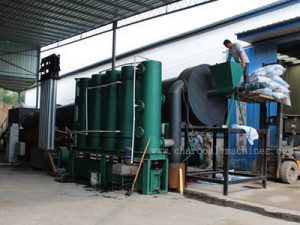Knowing how to operate, then the next step is the control of the temperature, the burner of the burner is sprayed, the carbonization tube is heated, the thermocouple is extended in the furnace body, and the space inside the furnace is displayed on the temperature control instrument on the panel of the control cabinet through the wire. temperature. (The actual temperature inside the carbonization tube will be 200~300° higher than the measured temperature in the furnace.) Environmentally friendly carbonization equipment, heated in the furnace for 15-20 minutes. When the temperature reaches 550-600 degrees, press the start button of the loading machine, the screw in the screw machine rotates, and the feeding of the feeding machine starts feeding. The carbonized shell material will rotate along the spiral of the screw machine. The pipe body climbs the material to the feed port above the carbonization machine.


Mengetahui cara mengoperasikan, lalu langkah selanjutnya adalah kontrol suhu, burner burner disemprot, tabung karbonisasi dipanaskan, termokopel diperpanjang di badan tungku, dan ruang di dalam tungku ditampilkan pada instrumen kontrol suhu pada panel kabinet kontrol melalui kawat. suhu. (Suhu sebenarnya di dalam tabung karbonisasi akan 200~300° lebih tinggi dari suhu yang terukur di tungku.) Peralatan karbonisasi ramah lingkungan, dipanaskan dalam tungku selama 15-20 menit. Ketika suhu mencapai 550-600 derajat, tekan tombol start mesin pemuat, sekrup di mesin sekrup berputar, dan pengumpanan mesin pengumpanan mulai memberi makan. Bahan cangkang yang terkarbonisasi akan berputar di sepanjang spiral mesin sekrup. Badan pipa menaikkan material ke port umpan di atas mesin karbonisasi.
Ketika bahan cangkang kelapa diisi ke dalam mesin karbonisasi, tekan tombol mulai furnace karbonisasi, tekan saklar merah pada pengatur elektromagnetik ke posisi ON, dan perlahan putar tombol kontrol kecepatan untuk membuat pengatur menunjukkan jarum deviasi, menunjukkan bahwa sekitar 500-600 rpm (cocok untuk cangkang kelapa), auger mesin karbonisasi diputar oleh spiral, mendorong bahan ke depan, mengaduk, dan bergerak, di tabung karbonisasi pertama dan kedua di bagian atas dan bawah. Pengeringan awal, air dalam endapan dibuang melalui pipa knalpot. Cerobong asap dibuang ke udara, dan bahan berada di dalam pipa. Ketika satu atau dua pipa dikeringkan menjadi pipa ketiga, air telah mengendap dan dibersihkan. Selama tahap karbonisasi suhu rendah, setelah kemajuan, pergerakan, dan pengadukan yang terus menerus, ketika memasuki pipa keempat, bahan diputar, diaduk, didorong, dan bergerak melalui jarak dalam tubuh pipa suhu tinggi untuk menyelesaikan karbon dari suhu bawah ke suhu tinggi. Selama proses konversi karbon, karbon suhu tinggi yang dihasilkan akhirnya dibuang dari port pembuangan mesin karbonisasi ke inlet mesin pendingin dan pemuatan tipe jaket air, dan bubuk karbon suhu tinggi dari tabung mesin pemuatan didinginkan oleh air pendingin yang mengelilingi tubuh pipa, dan akhirnya dari port pembuangan mesin pemuatan Toner dan jelaga setelah pendinginan, seperti yang dijelaskan sebelumnya, berulang kali, terus menerus bekerja untuk menyelesaikan seluruh proses karbonisasi produk cangkang kelapa.
